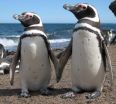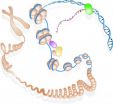(Press-News.org) NEWPORT, Ore. – Magellanic penguins have a high level of variation in genes associated with the ability to fight infectious disease, but a recent study found that the mechanism the penguins use to ensure that diversity is far from black and white.
Found exclusively south of the equator in South America, Magellanic penguins assemble in large nesting colonies along the coasts of Argentina, Chile, and the Falkland Islands. They typically mate for life, producing clutches of two eggs that are cared for by both parents. While individual colonies can number in the millions of birds, the species as a whole appears to be in decline, and is therefore classified as "Near Vulnerable" by the IUCN Red List.
A recent study published via Advance Access (doi: 10.1093/jhered/ess054) in the Journal of Heredity tested whether the significant diversity in the Major Histocompatibility Complex (MHC) genome region observed in these birds is attributable to mate choice or genetic selection based on disease exposure.
The study first confirmed that MHC diversity is high in these birds compared to other closely-related penguin species. Gabrielle Knafler, a graduate student at Bowling Green University and the first author of the study, explained, "By looking at the MHC genotypes of 50 breeding pairs of Magellanic penguins, we found considerable levels of genetic variation, detecting a significantly greater number of MHC variants or alleles than those reported for Galapagos penguins and Humboldt penguins." Forty-five alleles were found at the gene locus for the Magellanic penguins, sampled from a wild population in southern Patagonia, compared to 3 for Galapagos penguins and 7 for captive Humboldt penguins.
The authors of this study then investigated two possible mechanisms for maintaining the high MHC diversity in the Magellanic penguins: balancing selection, in which heterozygous individuals are better adapted to combat a wide range of diseases and are therefore more likely to survive to pass on their genes, and disassortative mating, or preferentially choosing a mate with a different MHC genotype.
How might a penguin know that a potential mate has different MHC genes? Smell could tell. Dr. Juan L. Bouzat of Bowling Green University, the lead scientist on the study, said, "In some species in which disassortative mating has been detected, individuals discriminate among potential mates by MHC type on the basis of olfactory cues."
To test the mechanism for maintaining MHC diversity, the authors studied the genetic variation of 50 breeding pairs of penguins. They examined whether MHC diversity was greater between breeding pairs as compared to random mating, and determined whether MHC genotype was correlated with measures of reproductive fitness, such as number of eggs hatched and number of chicks fledged.
Surprisingly, they found no direct evidence for disassortative mating based on the genotypes of the breeding pairs. Incidence of shared alleles between males and females in breeding pairs was not significantly different from what would be expected by chance.
But heterozygosity was found to be associated with increased fitness of adults, as heterozygous females hatched significantly more eggs and fledged significantly more chicks than homozygous females (in fact, none of the homozygous females that hatched eggs actually fledged any chicks). This finding suggests that a mechanism for balancing selection is at work in maintaining MHC diversity, even if it is not promoted by disassortative mating.
Other evidence for balancing selection was also found, including a gene phylogeny for MHC alleles from Magellanic, Humboldt, and Galapagos penguins. This analysis, akin to developing a "family tree" for genes, found that MHC alleles did not group together by species, suggesting that balancing selection has maintained different alleles even as species evolved over millions of years.
"There are likely other mechanisms at work as well," said Bouzat. "Spatial and temporal patterns in exposure to different pathogens may shape which alleles are favored at different times," changing selection pressures on the MHC genes. "The direct association of MHC genes with mechanisms of disease resistance suggests that the maintenance of MHC diversity could be driven by periodic selection due to different pathogens, similar to epidemics in humans."
INFORMATION:
Picky penguins: Does mate choice depend on genes that help resist disease?
2012-09-06
ELSE PRESS RELEASES FROM THIS DATE:
NFL players may be at higher risk of death from Alzheimer's and ALS
2012-09-06
MINNEAPOLIS – New research shows that professional football players may be at a higher risk of death from diseases that damage the cells in the brain, such as Alzheimer's disease and ALS (also known as Lou Gehrig's disease), compared to the general U.S. population. The study is published in the September 5, 2012, online issue of Neurology®, the medical journal of the American Academy of Neurology.
The study included 3,439 players with an average age of 57 from the National Football League with at least five playing seasons from 1959-1988. Researchers reviewed death ...
The best strategy to defeat HIV in South Africa
2012-09-06
The World Health Organization is about to roll out a new strategy for AIDS prevention in South Africa, a country where more than 5 million people are infected with HIV. Based on a mathematical model, the WHO predicts this strategy will completely eliminate HIV in South Africa within a decade.
But not so fast, suggests a group of UCLA researchers. Their work challenges the proposed strategy by showing it could lead to several million individuals developing drug-resistant strains of HIV. And further, they say, it will cost billions of dollars more than the WHO has estimated. ...
Study in mice suggests sleep problems may be early sign of Alzheimer's
2012-09-06
Sleep disruptions may be among the earliest indicators of Alzheimer's disease, scientists at Washington University School of Medicine in St. Louis report Sept. 5 in Science Translational Medicine.
Working in a mouse model, the researchers found that when the first signs of Alzheimer's plaques appear in the brain, the normal sleep-wake cycle is significantly disrupted.
"If sleep abnormalities begin this early in the course of human Alzheimer's disease, those changes could provide us with an easily detectable sign of pathology," says senior author David M. Holtzman, MD, ...
Animal study finds anti-HIV vaginal ring can prevent virus transmission
2012-09-06
Population Council scientists have found that a vaginal ring releasing an anti-HIV drug can prevent the transmission of SHIV in macaques. This study provides the first efficacy data on the delivery of a microbicide from a vaginal ring, and indicates strong potential for the success of such rings in women. Microbicides are compounds that can be applied inside the vagina or rectum to protect against sexually transmitted infections (STIs), including HIV.
"This proof-of-concept study confirms that the investment in vaginal rings as a delivery system for HIV prevention is ...
Researchers unlock disease information hidden in genome's control circuitry
2012-09-06
Researchers at the University of Washington have determined that the majority of genetic changes associated with more than 400 common diseases and clinical traits affect the genome's regulatory circuitry. These are the regions of DNA that contain instructions dictating when and where genes are switched on or off. Most of these changes affect circuits that are active during early human development, when body tissues are most vulnerable.
By creating extensive blueprints of the control circuitry, the research also exposed previously hidden connections between different ...
Fast forward for biomedical research: ENCODE scraps the junk
2012-09-06
The hundreds of researchers working on the ENCODE project have revealed that much of what has been called 'junk DNA' in the human genome is actually a massive control panel with millions of switches regulating the activity of our genes. Without these switches, genes would not work – and mutations in these regions might lead to human disease. The new information delivered by ENCODE is so comprehensive and complex that it has given rise to a new publishing model in which electronic documents and datasets are interconnected.
Just as the Human Genome Project revolutionised ...
Albatross 'dynamic soaring' achieved by repeated curve-altitude oscillation
2012-09-06
Albatrosses leverage the energy of the wind to fly with essentially no mechanical cost to themselves, very rarely flapping their wings, and new work published Sep. 5 in the open access journal PLOS ONE offers insight into how exactly they accomplish this feat.
The researchers, led by Gottfried Sachs of the Technische Universitaet Muenchen and Francesco Bonadonna of the French National Centre for Scientific Research (CNRS), used advanced GPS tracking to determine that the energy gain during the albatross's "dynamic soaring" comes from a repeated oscillation consisting ...
Fathers who sleep closer to children have lower testosterone levels
2012-09-06
Closer sleeping proximity between fathers and children is associated with a greater decrease in the father's testosterone level, with possible implications for parenting behavior. The full report is published Sep. 5 in the open access journal PLOS ONE.
Fathers' testosterone levels have been associated with parenting behavior and involvement across species, with higher levels generally associated with lower parental involvement. The authors of the current study, led by Lee Gettler of the University of Notre Dame, studied 362 fathers in the Philippines to determine whether ...
Huge human gene study includes Penn State University research
2012-09-06
The first integrated understanding of how the human genome functions will be published this week -- the triumphant result of a collaborative five-year project involving more than 440 researchers working in 32 labs worldwide. The Encyclopedia of DNA Elements project, known as ENCODE, will publish simultaneously on 6 September 2012 a massive number of scientific papers, including 1 main integrative paper and 5 others in Nature; 18 in Genome Research; 6 in Genome Biology; and other affiliated papers in Science, Cell, and other scientific journals.
During the ENCODE study, ...
Yale team finds order amidst the chaos within the human genome
2012-09-06
Within the genome, sex does matter
Yale researchers studying the human genome say they can now tell how much "mom" and how much "dad" is genetically active in each of us.
These gender-specific markers may not determine which parent can take credit — or the blame — for the successes or shortcomings of their offspring; however, they could help explain differences in human populations.
"We can now track the relative genetic contribution of mom and dad," said Gerstein.
All human beings are born with two copies of the genome — one from the mother and one from the father. ...



